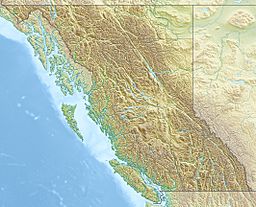Gamuza Peak facts for kids
Quick facts for kids Gamuza Peak |
|
|---|---|

Gamuza Peak seen from Alpaca Peak
|
|
| Highest point | |
| Elevation | 1,944 m (6,378 ft) |
| Prominence | 194 m (636 ft) |
| Parent peak | Steinbok Peak (2127 m) |
| Geography | |
| Location | British Columbia, Canada |
| Parent range | North Cascades |
| Topo map | NTS 92H/11 |
| Climbing | |
| First ascent | 1976 by Philip Kubik, Grant McCormack |
| Easiest route | Scrambling via south slope |
Gamuza Peak is a mountain in British Columbia, Canada. It stands 1,944-metre (6,378-foot) tall. This mountain is part of the North Cascades range in southwestern British Columbia.
It's located about 12 km (7 mi) west-northwest of Coquihalla Summit. The closest taller mountain is Steinbok Peak, which is just 1.3 km (1 mi) to the northwest. Rain and melting snow from Gamuza Peak flow into streams that lead to the Anderson River.
The mountain got its name, Gamuza, from the Spanish word for the Pyrenean chamois. This name was chosen to fit a theme of naming nearby peaks after ungulates (hoofed animals). Philip Kubik, who was part of the first group to climb the mountain, suggested the name. The name was officially accepted on February 5, 1976.
Contents
How Mountains Form: Geology of Gamuza Peak
The Cascade Range, where Gamuza Peak is located, began forming millions of years ago. This process started during the late Eocene Epoch. The North American Plate slowly moved over the Pacific Plate. This movement caused many volcanic eruptions and created new rock.
Small pieces of the Earth's crust, called terranes, also joined together. These pieces helped form the North Cascades about 50 million years ago.
Ice Age and Mountain Shapes
Over two million years ago, during the Pleistocene period, huge sheets of ice called glaciers covered the land. These glaciers moved forward and backward many times. As they moved, they carved out the landscape.
You can see the results of this today in the "U"-shaped river valleys. These valleys were shaped by the glaciers. The powerful forces of uplift (when land pushes up) and faulting (when cracks form in the Earth's crust) also played a big role. Together with glaciation, these forces created the tall peaks and deep valleys you see in the North Cascades.
The North Cascades has some of the most rugged land in the Cascade Range. It features sharp peaks, long ridges, deep glacial valleys, and tall granite spires. These geological events created a varied landscape with big changes in elevation. This also leads to different climates and types of plants in various ecoregions.
Weather and Climate at Gamuza Peak
Gamuza Peak is in a marine west coast climate zone. This means it has mild, wet winters and cool, drier summers. Most of the weather systems come from the Pacific Ocean. They travel east towards the Cascade Range.
When these weather systems hit the mountains, they are forced to rise. This process is called Orographic lift. As the air rises, it cools and drops its moisture. This causes a lot of rain or snow to fall on the mountains. Because of this, the Cascade Mountains get a lot of precipitation, especially snow in winter.
Winter temperatures can drop very low, sometimes below −20 °C. With the wind, it can feel even colder, below −30 °C. If you want to climb Gamuza Peak, the best time to visit is usually from July through September. The weather is most favorable then.
Climbing Routes on Gamuza Peak
There are several known paths to climb Gamuza Peak. Here are some of the established routes:
- West Ridge - class 3 (First climbed in 1976)
- North Ridge/NW Arête - class 5 (First climbed in 1976)
- East Ridge - class 3 (First climbed in 1976)
- Backslide Buttress - class 5.6+ (First climbed in 2002)
- South Slopes - class 3



